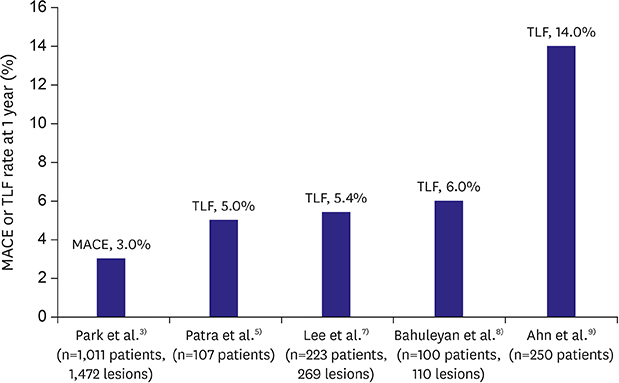Korean Circ J.
2019 Aug;49(8):721-723. 10.4070/kcj.2019.0150.
Diffuse Long Coronary Artery Disease is Still an Obstacle for Percutaneous Coronary Intervention in the Second-Generation Drug-Eluting Stent Era?
- Affiliations
-
- 1Division of Cardiology, Department of Internal Medicine, Gachon University College of Medicine, Gachon University Gil Medical Center, Incheon, Korea. shhan@gilhospital.com
- KMID: 2456866
- DOI: http://doi.org/10.4070/kcj.2019.0150
Abstract
- No abstract available.
MeSH Terms
Figure
Reference
-
1. Gwon HC, Jeon DW, Kang HJ, et al. The practice pattern of percutaneous coronary intervention in Korea: based on year 2014 cohort of Korean percutaneous coronary intervention (K-PCI) registry. Korean Circ J. 2017; 47:320–327.
Article2. Bourassa MG, Lespérance J, Eastwood C, et al. Clinical, physiologic, anatomic and procedural factors predictive of restenosis after percutaneous transluminal coronary angioplasty. J Am Coll Cardiol. 1991; 18:368–376.
Article3. Park KH, Ahn Y, Koh YY, et al. Effectiveness and safety of zotarolimus-eluting stent (Resolute™ integrity) in patients with diffuse long coronary artery disease. Korean Circ J. 2019; 49:709–720.
Article4. Taniwaki M, Stefanini GG, Silber S, et al. 4-year clinical outcomes and predictors of repeat revascularization in patients treated with new-generation drug-eluting stents: a report from the RESOLUTE All-Comers trial (A Randomized Comparison of a Zotarolimus-Eluting Stent With an Everolimus-Eluting Stent for Percutaneous Coronary Intervention). J Am Coll Cardiol. 2014; 63:1617–1625.5. Patra S, Chakraborty RN, Pande A, et al. Zotarolimus-eluting resolute integrity versus everolimus-eluting Xience Xpedition stents in the management of very long (>30mm) de novo coronary artery stenosis. Cardiovasc Revasc Med. 2017; 18:160–164.6. Chang SH, Chen CC, Hsieh MJ, Wang CY, Lee CH, Hsieh IC. Lesion length impacts long term outcomes of drug-eluting stents and bare metal stents differently. PLoS One. 2013; 8:e53207.
Article7. Lee M, Hiremath S, Zambahari R, Leon M, Mauri L, Yeung A. RESOLUTE US and RESOLUTE Asia Investigators. One-year outcomes of percutaneous coronary intervention with the 38-mm Resolute zotarolimus-eluting stent. Am J Cardiol. 2013; 112:1335–1341.
Article8. Bahuleyan CG, Krishna Kumar VV, Babu S. Prospective study to evaluate safety and efficacy of Zotarolimus Eluting Stent (PSEZES) in patients with long coronary artery lesions. Indian Heart J. 2015; 67:233–238.
Article9. Ahn JM, Park DW, Kim YH, et al. Comparison of resolute zotarolimus-eluting stents and sirolimus-eluting stents in patients with de novo long coronary artery lesions: a randomized LONG-DES IV trial. Circ Cardiovasc Interv. 2012; 5:633–640.10. Hong SJ, Kim BK, Shin DH, et al. Effect of Intravascular ultrasound-guided vs angiography-guided everolimus-eluting stent implantation: the IVUS-XPL randomized clinical trial. JAMA. 2015; 314:2155–2163.
- Full Text Links
- Actions
-
Cited
- CITED
-
- Close
- Share
- Similar articles
-
- Recent Advances in Percutaneous Coronary Intervention in Coronary Artery Disease
- Novel Coronary Stent Platforms
- A Bumpy and Winding but Right Path to Domestic Drug-Eluting Coronary Stents
- Successful Treatment of a Coronary Artery Aneurysm that Developed with In-Stent Restenosis after Drug-Eluting Stent Implantation
- Two Cases of Immediate Stent Fracture after Zotarolimus-Eluting Stent Implantation


